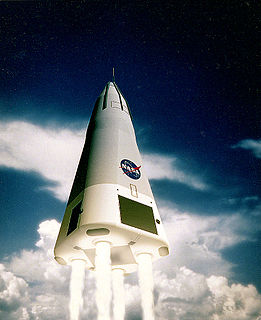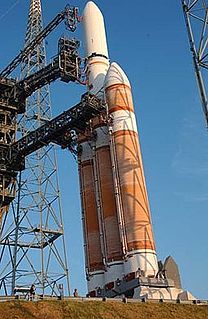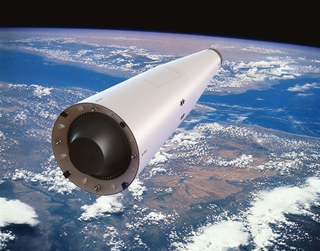
A single-stage-to-orbit vehicle reaches orbit from the surface of a body without jettisoning hardware, expending only propellants and fluids. The term usually, but not exclusively, refers to reusable vehicles. No Earth-launched SSTO launch vehicles have ever been constructed. To date, orbital launches have been performed either by multi-stage fully or partially expendable rockets, the Space Shuttle having both attributes.

Liquid oxygen—abbreviated LOx, LOX or Lox in the aerospace, submarine and gas industries—is the liquid form of elemental oxygen. It was used as the oxidizer in the first liquid-fueled rocket invented in 1926 by Robert H. Goddard. It was later mostly supplanted by gaseous oxidizers such as nitrogen tetroxide because of easier storage, as is the case with the American Titan II missile from the Cold War.

A spaceplane is an aerospace vehicle that operates as an aircraft in Earth's atmosphere, as well as a spacecraft when it is in space. It combines features of an aircraft and a spacecraft, which can be thought of as an aircraft that can endure and maneuver in the vacuum of space or likewise a spacecraft that can fly like an airplane. Typically, it takes the form of a spacecraft equipped with wings, although lifting bodies have been designed and tested as well. The propulsion to reach space may be purely rocket based or may use the assistance of airbreathing jet engines. The spaceflight is then followed by an unpowered glide return to landing.

The Lockheed Martin X-33 was an unmanned, sub-scale technology demonstrator suborbital spaceplane developed in the 1990s under the U.S. government-funded Space Launch Initiative program. The X-33 was a technology demonstrator for the VentureStar orbital spaceplane, which was planned to be a next-generation, commercially operated reusable launch vehicle. The X-33 would flight-test a range of technologies that NASA believed it needed for single-stage-to-orbit reusable launch vehicles, such as metallic thermal protection systems, composite cryogenic fuel tanks for liquid hydrogen, the aerospike engine, autonomous (unmanned) flight control, rapid flight turn-around times through streamlined operations, and its lifting body aerodynamics.

The DC-X, short for Delta Clipper or Delta Clipper Experimental, was an unmanned prototype of a reusable single-stage-to-orbit launch vehicle built by McDonnell Douglas in conjunction with the United States Department of Defense's Strategic Defense Initiative Organization (SDIO) from 1991 to 1993. Starting 1994 until 1995, testing continued through funding of the US civil space agency NASA. In 1996, the DC-X technology was completely transferred to NASA, which upgraded the design for improved performance to create the DC-XA.

SABRE is a concept under development by Reaction Engines Limited for a hypersonic precooled hybrid air-breathing rocket engine. The engine is being designed to achieve single-stage-to-orbit capability, propelling the proposed Skylon spaceplane to low Earth orbit. SABRE is an evolution of Alan Bond's series of liquid air cycle engine (LACE) and LACE-like designs that started in the early/mid-1980s for the HOTOL project.

The Aerojet Rocketdyne RS-25, otherwise known as the Space Shuttle main engine (SSME), is a liquid-fuel cryogenic rocket engine that was used on NASA's Space Shuttle. NASA is planning to continue using the RS-25 on the Space Shuttle's successor, the Space Launch System (SLS).
The highest specific impulse chemical rockets use liquid propellants. They can consist of a single chemical or a mix of two chemicals, called bipropellants. Bipropellants can further be divided into two categories; hypergolic propellants, which ignite when the fuel and oxidizer make contact, and non-hypergolic propellants which require an ignition source.

H-IIB (H2B) is an expendable launch system used to launch H-II Transfer Vehicles towards the International Space Station. H-IIB rockets are liquid-fuelled with solid-fuel strap-on boosters and are launched from the Tanegashima Space Center in Japan. Mitsubishi and JAXA have been primarily responsible for design, manufacture, and operation of H-IIB. H-IIB made its first flight in 2009, and had made a total of seven flights through 2018.

A modular rocket is a type of multistage rocket which features components that can be interchanged for specific mission requirements. Several such rockets use similar concepts such as unified modules to minimize expenses on manufacturing, transportation and for optimization of support infrastructure for flight preparations.

The H-II (H2) rocket was a Japanese satellite launch system, which flew seven times between 1994 and 1999, with five successes. It was developed by NASDA in order to give Japan a capability to launch larger satellites in the 1990s. It was the first two-stage liquid-fuelled rocket Japan made using only technologies developed domestically. It was superseded by the H-IIA rocket following reliability and cost issues.
The Tupolev Tu-2000 was a planned hypersonic flight experimental aircraft designed by the Tupolev design bureau. It was intended to test technologies for a single-stage-to-orbit aerospaceplane and also the Tupolev Tu-360 intercontinental bomber.

The XCOR Lynx was a proposed suborbital horizontal-takeoff, horizontal-landing (HTHL), rocket-powered spaceplane that was under development by the California-based company XCOR Aerospace to compete in the emerging suborbital spaceflight market. The Lynx was intended to carry one pilot, a ticketed passenger, and/or a payload above 100 km altitude. The concept was under development since 2003, when a two-person suborbital spaceplane was announced under the name Xerus.

Kakuda Space Center is a facility of the Japan Aerospace Exploration Agency (JAXA), located in the city of Kakuda in Miyagi Prefecture in northern Japan, specializing in the development and testing of rocket engines and space propulsion systems. The LE-5, and the LE-7 rocket enginese were developed at the Kakuda Space Center.

The Falcon 9 v1.0 was the first member of the Falcon 9 launch vehicle family, designed and manufactured by SpaceX in Hawthorne, California. Development of the medium-lift launcher began in 2005, and it first flew in June 2010. The Falcon 9 v1.0 then launched four Dragon cargo spacecraft: one on an orbital test flight, then one demonstration and two operational resupply missions to the International Space Station under a Commercial Resupply Services contract with NASA.

Zero 2 Infinity is a private Spanish company developing high-altitude balloons to provide access to near space and low Earth orbit using a balloon-borne pod and a balloon-borne launcher.
The New Glenn is a heavy-lift orbital launch vehicle in development by Blue Origin. Design work on the vehicle began in 2012. The vehicle itself, and the high-level specifications, were initially publicly unveiled in September 2016. New Glenn is described as a two-stage rocket with a diameter of 7 meters (23 ft). Its first stage will be powered by seven BE-4 engines that are also being designed and manufactured by Blue Origin.
WIRES is a Japanese project developing a winged single-stage reusable suborbital rocket as a test bed for a reusable orbital launch system or a crewed suborbital spaceplane. The full-size prototype, called WIRES-X, is expected to be launched in 2020.



















